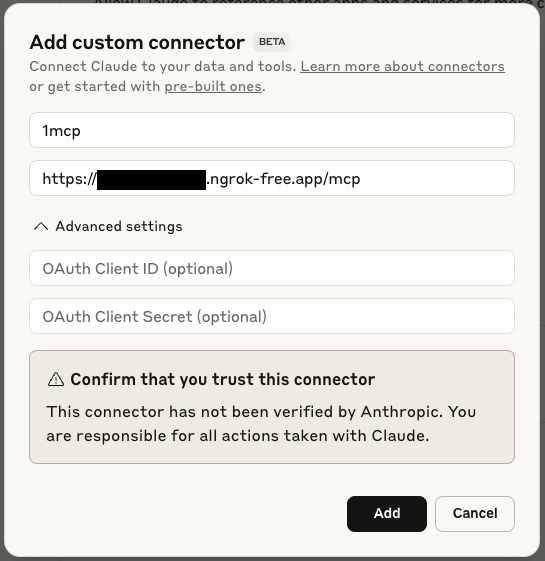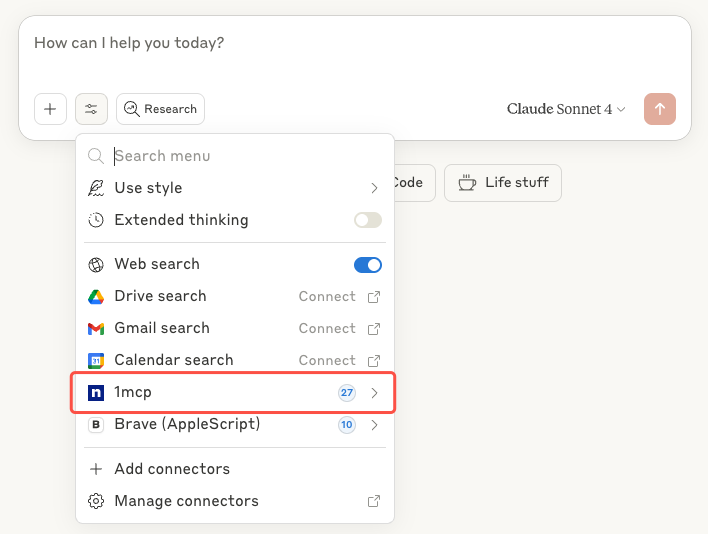Claude Desktop Integration
Learn how to integrate your 1MCP server with Claude Desktop using two different approaches: local configuration consolidation (recommended for simplicity) and remote custom connectors (for advanced use cases).
Integration Approaches
1. Local Configuration Consolidation (Recommended)
The simplest approach is to consolidate your existing MCP servers into Claude Desktop's configuration using 1MCP as a local proxy. This approach:
- Uses stdio transport (no network setup required)
- Automatically configures Claude Desktop to use 1MCP
- Preserves your existing MCP server configurations
- Works entirely offline with no HTTPS/tunneling requirements
2. Remote Custom Connectors (Advanced)
For advanced scenarios, you can connect to a remote 1MCP server using Claude Desktop's custom connector feature with HTTP or SSE transport. This approach:
- Requires public HTTPS URL (tunneling/reverse proxy)
- Supports OAuth authentication
- Enables remote access to centralized 1MCP servers
- Useful for team/enterprise deployments
Why Use 1MCP with Claude Desktop?
- Direct Integration: Connect remotely without local setup
- Unified Access: Access multiple MCP servers through one endpoint
- Authentication: Built-in OAuth 2.1 support for secure connections
- Server Management: Centralized management of all your MCP tools
- Hot Reloading: Add/remove servers without restarting Claude Desktop
Quick paths
Choose your approach
- Local (Recommended): No networking; 1MCP runs via stdio and auto-wires Claude Desktop
- Remote (Advanced): Expose 1MCP over HTTPS and add a custom connector
Local setup (Recommended)
# Optionally add some servers first
npx -y @1mcp/agent mcp add context7 -- npx -y @upstash/context7-mcp
npx -y @1mcp/agent mcp add sequential -- npx -y @modelcontextprotocol/server-sequential-thinking
# Consolidate Claude Desktop to use 1MCP via stdio
npx -y @1mcp/agent app consolidate claude-desktop --dry-run # Preview
npx -y @1mcp/agent app consolidate claude-desktopThen restart Claude Desktop. Backups are created automatically; restore anytime:
npx -y @1mcp/agent app backups claude-desktop
npx -y @1mcp/agent app restore claude-desktopRemote custom connector (Advanced)
- Start server
npx -y @1mcp/agent serve --transport http --port 3001 --external-url https://your-domain.com # dev
npx -y @1mcp/agent serve --transport http --port 3001 --enable-auth --external-url https://your-domain.com # prodServed paths: /mcp (Streamable HTTP), /sse + /messages (SSE), /oauth (OAuth), /health (health).
- Expose server over HTTPS
- ngrok:
ngrok http 3001→ usehttps://<id>.ngrok-free.app/mcp - Reverse proxy:
- nginx: proxy
location /→http://localhost:3001(HTTP/1.1, buffering off) - Caddy:
reverse_proxy localhost:3001 - Traefik: router for host → service
1mcpon port 3001
- nginx: proxy
- Add connector in Claude Desktop
- Name: any (e.g., "1mcp")
- URL: your public
https://.../mcp - Optional: OAuth Client ID/Secret
Note: OAuth 2.1 validates the issuer URL. Always set
--external-urlto your public origin (for example,https://your-domain.comorhttps://abc123.ngrok-free.app).
- Use HTTPS
- Do not include a path (no
/mcp)- Match exactly what Claude Desktop uses
Step 2: Add Custom Connector in Claude Desktop
Open Claude Desktop Settings
- Click on your profile/settings in Claude Desktop
- Navigate to "Connectors" or look for connector management
Add Custom Connector
- Click "Add custom connector"
- You'll see a dialog like this:

Enter Connection Details
- Name: Enter a name for your connector (e.g., "1mcp")
- URL: Enter your public HTTPS URL:
- With ngrok:
https://abc123.ngrok-free.app/mcp - With reverse proxy:
https://your-domain.com/mcp
- With ngrok:
- OAuth Client ID (optional): If using authentication
- OAuth Client Secret (optional): If using authentication
Confirm Trust
- Review the security warning
- Click "Add" to confirm you trust this connector
Step 3: Verify Connection
After adding the connector, you should see your 1MCP tools available:

The tools shown will depend on which MCP servers you have configured in your 1MCP instance. Common tools include:
- Context7 library documentation tools
- Sequential thinking tools
- Playwright browser automation
- And any other MCP servers you've added
Step 4: Use Your Tools
Once connected, your 1MCP tools will appear in Claude Desktop's interface:

You can now use these tools directly in your conversations with Claude.
💡 Tip: If any service shows "Awaiting OAuth", open your server's OAuth dashboard at
https://your-domain.com/oauthand click Authorize for that service. Then retry in Claude Desktop.
Server quick config
# Start
npx -y @1mcp/agent serve --transport http --port 3001 --external-url https://your-domain.com
# Enable auth (recommended for production)
npx -y @1mcp/agent serve --transport http --port 3001 --enable-auth --external-url https://your-domain.com
# Filter exposed servers by tags
npx -y @1mcp/agent serve --transport http --port 3001 --tags "context7,sequential" --external-url https://your-domain.com
# Bind to all interfaces (behind reverse proxy)
npx -y @1mcp/agent serve --transport http --port 3001 --host 0.0.0.0 --external-url https://your-domain.comAuthentication
- Enable:
npx -y @1mcp/agent serve --transport http --port 3001 --enable-auth - Configure Client ID/Secret in Claude Desktop if needed; OAuth flow is automatic
Troubleshooting
Local Configuration Issues
Tools Not Appearing After Consolidation
Symptoms: Consolidation completes but tools don't appear in Claude Desktop.
Solutions:
Restart Claude Desktop: Ensure you've completely restarted Claude Desktop after consolidation
Check Configuration: Verify the consolidation worked correctly
bash# Check the generated configuration cat "~/Library/Application Support/Claude/claude_desktop_config.json"Test 1MCP Server: Verify 1MCP is working correctly
bash# Check server status npx -y @1mcp/agent mcp status # Test stdio transport echo '{"jsonrpc": "2.0","id": 1,"method": "initialize","params": {"protocolVersion": "2025-06-18","capabilities": {},"clientInfo": {"name": "ExampleClient","title": "Example Client Display Name","version": "1.0.0"}}}' | npx -y @1mcp/agent serve --transport stdio
"Consolidation Failed" Error
Symptoms: The consolidation command fails with errors.
Solutions:
Use Force Flag: Skip connectivity validation
bashnpx -y @1mcp/agent app consolidate claude-desktop --forceCheck Permissions: Ensure write access to Claude Desktop's config directory
bashls -la "~/Library/Application Support/Claude/"Manual Cleanup: If consolidation is partially complete
bash# Restore from backup npx -y @1mcp/agent app restore claude-desktop # Or manually reset npx -y @1mcp/agent app consolidate claude-desktop --force
"Configuration Backup Failed" Error
Symptoms: Unable to create backup of existing configuration.
Solutions:
- Check Disk Space: Ensure sufficient disk space
- Check Permissions: Verify write access to backup directory
- Use Force Mode: Proceed without backup (use with caution)bash
npx -y @1mcp/agent app consolidate claude-desktop --force --backup-only
Remote Custom Connector Issues
"Failed to Connect" Error
Symptoms: Claude Desktop shows connection failed when adding the connector.
Solutions:
Check Server Status: Ensure your 1MCP server is running
bashnpx -y @1mcp/agent mcp status # Check if servers are runningVerify URL: Ensure the URL is correct and accessible
bash# Health endpoints are served at /health (not under /mcp) curl https://your-domain.com/health # Test basic connectivityCheck Firewall: Ensure the port is open and accessible
Tools Not Appearing
Symptoms: Connector connects but no tools are visible.
Solutions:
Check Server Configuration: Verify MCP servers are properly configured
bashnpx -y @1mcp/agent mcp list # List configured serversRestart Both: Restart both 1MCP and Claude Desktop
Authentication Issues
Symptoms: OAuth authentication fails or keeps asking for credentials.
Solutions:
- Check OAuth Configuration: Ensure OAuth is enabled in 1MCP
- Issuer match: Set
--external-urlto your public HTTPS origin (no path) and ensure it matches Claude’s connector URL origin exactly - Verify Credentials: Double-check Client ID and Secret in Claude Desktop
- Clear Cache: Try removing and re-adding the connector
Debugging Steps
Test Direct Connection:
bash# Test your exposed HTTPS endpoint curl -X POST https://your-domain.com/mcp \ -H "Content-Type: application/json" \ -d '{"jsonrpc": "2.0","id": 1,"method": "initialize","params": {"protocolVersion": "2025-06-18","capabilities": {},"clientInfo": {"name": "ExampleClient","title": "Example Client Display Name","version": "1.0.0"}}}'Check Server Logs:
bashLOG_LEVEL=debug npx -y @1mcp/agent serve --transport http --port 3001Health Check:
bash# Check if server is responding through your proxy/tunnel curl https://your-domain.com/health
Security Considerations
Production Deployment
- HTTPS via reverse proxy (nginx/Caddy/Traefik)
- Enable OAuth in production:
--enable-auth - Harden network: firewall, VPN/private networks, rate limiting at proxy, bind to localhost when proxied
Trust and Permissions
- Review Carefully: Only connect to trusted 1MCP servers
- Understand Permissions: Review what tools will be accessible
- Regular Audits: Periodically review connected connectors and their permissions
Advanced Usage
Multiple Environments
You can add multiple 1MCP connectors for different environments:
Development Environment:
- Name: "1MCP Dev"
- URL:
https://dev-abc123.ngrok-free.app/mcp(using ngrok)
Production Environment:
- Name: "1MCP Prod"
- URL:
https://prod-server.com/mcp - OAuth credentials for production
Server Filtering
Control which tools are available by filtering servers:
# Only expose specific capabilities
npx -y @1mcp/agent serve --transport http --port 3001 --tags "context7,sequential"Best Practices
Local
- Discover first →
app discover - Preview →
--dry-run - Backups are automatic
- Restart Claude Desktop after consolidation
- Keep agent updated; monitor with
mcp status
Remote
- Start simple (no auth), then add OAuth + HTTPS for prod
- Health checks + monitoring
- Review permissions regularly; keep servers updated
Examples
Local (recommended)
# 1. Install 1MCP agent
npm install -g @1mcp/agent
# 2. Add some useful MCP servers
npx -y @1mcp/agent mcp add context7 -- npx -y @upstash/context7-mcp
npx -y @1mcp/agent mcp add sequential -- npx -y @modelcontextprotocol/server-sequential-thinking
npx -y @1mcp/agent mcp add playwright -- npx -y @playwright/mcp
# 3. Preview what consolidation will do
npx -y @1mcp/agent app consolidate claude-desktop --dry-run
# 4. Consolidate Claude Desktop configuration
npx -y @1mcp/agent app consolidate claude-desktop
# 5. Restart Claude Desktop
# 6. Verify tools are available in Claude Desktop
npx -y @1mcp/agent mcp status # Check server healthYour Claude Desktop will now use the following configuration automatically:
{
"mcpServers": {
"1mcp": {
"command": "npx",
"args": ["-y", "@1mcp/agent", "serve", "--transport", "stdio"]
}
}
}Remote + ngrok
For development setups where you need remote access:
# 1. Install and configure 1MCP
npm install -g @1mcp/agent
npx -y @1mcp/agent mcp add context7 -- npx -y @upstash/context7-mcp
npx -y @1mcp/agent mcp add sequential -- npx -y @modelcontextprotocol/server-sequential-thinking
# 2. Expose via ngrok
ngrok http 3001
# 3. Start server, use the URL from ngrok
npx -y @1mcp/agent serve --transport http --port 3001 --external-url https://abc123.ngrok-free.app
# 4. Add connector in Claude Desktop:
# - Name: "My 1MCP Server"
# - URL: "https://abc123.ngrok-free.app/mcp" (use the URL from ngrok)
# 5. Verify tools are available in Claude DesktopProduction + Nginx
# 1. Start 1MCP server (bind to localhost for security)
npx -y @1mcp/agent serve --transport http --port 3001 --enable-auth --external-url https://your-domain.com
# 2. Configure nginx to proxy HTTPS to HTTP
# 3. Add connector in Claude Desktop:
# - Name: "Production 1MCP"
# - URL: "https://your-domain.com/mcp"
# - Add OAuth credentials
# 4. Verify tools are available in Claude DesktopGetting Help
If you encounter issues:
- Check the troubleshooting section above
- For local configuration issues:
- Try
npx -y @1mcp/agent app consolidate claude-desktop --force - Check
npx -y @1mcp/agent mcp statusfor server health - Use
npx -y @1mcp/agent app restore claude-desktopto rollback
- Try
- For remote connector issues:
- Review Anthropic's documentation on:
- Open an issue on our GitHub repository
- Check the 1MCP documentation for server configuration help
Which Approach Should I Use?
Choose Local Configuration Consolidation if:
- ✅ You want the simplest setup
- ✅ You're using Claude Desktop on your local machine
- ✅ You don't need remote access
- ✅ You want offline functionality
- ✅ You don't want to deal with HTTPS/tunneling
Choose Remote Custom Connectors if:
- ✅ You have a Claude Pro/Max/Team/Enterprise plan
- ✅ You need to access a centralized 1MCP server
- ✅ You're comfortable with networking/HTTPS setup
- ✅ You want to share MCP servers across multiple clients
- ✅ You need OAuth authentication
Next Steps
- Learn about authentication configuration
- Explore server filtering options
- Set up server management for your MCP servers
- Configure app consolidation for seamless management of other apps
